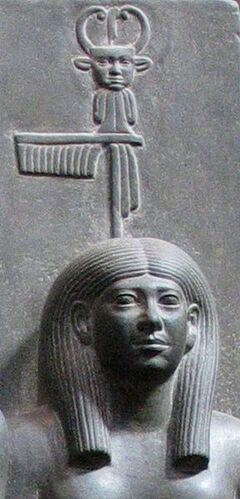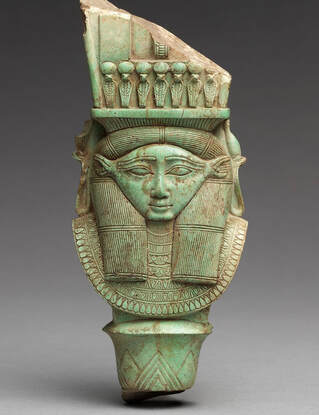Per-Bat
𓅡𓏏𓏣𓅆OK 𓅡𓄿𓏏𓄄 𓅡𓏣 𓅡𓏏𓆇
𓅡𓄿𓏏 𓏏𓁐NK 𓅡𓅡𓏏𓆇𓁐G-R
𓅡𓄿𓏏 𓏏𓁐NK 𓅡𓅡𓏏𓆇𓁐G-R
MDC: bAt , BAtA
Gardiner: bꜢt
Budge:
Transliteration: Bat
Coptic:
Hebrew: Bat/באט
Greek: (M) Bat/Μπατ
Demotic:
Arabic:
English:
Kemetic:
Alt: Bata (however should not be confused with the male Bata)
Pronounced: bat
Meaning: "female bA soul/spirit"- /bA/ 𓅡 "Ba Spirit" + /t/ 𓏏 "Female ending"
Gardiner: bꜢt
Budge:
Transliteration: Bat
Coptic:
Hebrew: Bat/באט
Greek: (M) Bat/Μπατ
Demotic:
Arabic:
English:
Kemetic:
Alt: Bata (however should not be confused with the male Bata)
Pronounced: bat
Meaning: "female bA soul/spirit"- /bA/ 𓅡 "Ba Spirit" + /t/ 𓏏 "Female ending"
Home: 7th Nome Upper Egypt-Hut-Sekhem/ Diospolis Parva , House of the Sistrum, 17th Nome Upper Egypt Anpu- Saka
Temple:
Nome: 7th nome UE
Consort
Children
Parents
Alternative Parentage
Siblings
Possibly Anpu (Saka 17th Nome Upper Egypt Anpu)
Possibly Bata (Saka 17th Nome Upper Egypt Anpu)
Priest names
Followers
Features
cow goddess with human like face with cow ears and horns. Typically she featured on sistrums and pillars or on stela with the Bat symbol from 7th nome UE, She is siad to have two faces although the answer to why veries.
Symbols
cows milk
cows (with horns that curl on diffaren then the cow associated with Hathor)
ankh ☥ (breath of life)
sistrum 𓏣
horns
stars 𓇼
𓈼 7th nome UE (Bat symbol/fetish)
Roles
Cow goddess of the milky way and the cosmos, fertility goddess who helped childless women conceive, her likeness was found on pillars and sistrums. In 7th Nome Upper Egypt embodiment soul.
Hybrid gods
Connection to other gods
Hut-hor/ Hathor (absorbed her NK+, 26th D-Greco-Roman period she became her own goddess again)
Bata (Possibly female form of him)
Celebrations
Offering items
Protects
Other names
Epitaphs
Bat of two faces (she has been said to have two faces) (Pyramid texts)
Mooing One and the Great Wild Cow
Great Wild Cow
Temple:
Nome: 7th nome UE
Consort
Children
Parents
Alternative Parentage
Siblings
Possibly Anpu (Saka 17th Nome Upper Egypt Anpu)
Possibly Bata (Saka 17th Nome Upper Egypt Anpu)
Priest names
Followers
Features
cow goddess with human like face with cow ears and horns. Typically she featured on sistrums and pillars or on stela with the Bat symbol from 7th nome UE, She is siad to have two faces although the answer to why veries.
Symbols
cows milk
cows (with horns that curl on diffaren then the cow associated with Hathor)
ankh ☥ (breath of life)
sistrum 𓏣
horns
stars 𓇼
𓈼 7th nome UE (Bat symbol/fetish)
Roles
Cow goddess of the milky way and the cosmos, fertility goddess who helped childless women conceive, her likeness was found on pillars and sistrums. In 7th Nome Upper Egypt embodiment soul.
Hybrid gods
Connection to other gods
Hut-hor/ Hathor (absorbed her NK+, 26th D-Greco-Roman period she became her own goddess again)
Bata (Possibly female form of him)
Celebrations
Offering items
Protects
Other names
Epitaphs
Bat of two faces (she has been said to have two faces) (Pyramid texts)
Mooing One and the Great Wild Cow
Great Wild Cow
I am Praise; I am Majesty; I am Bat with Her Two Faces; I am the One Who Is Saved,
and I have saved myself from all things evil.
(Pyramid Texts Utterance 506)
and I have saved myself from all things evil.
(Pyramid Texts Utterance 506)








